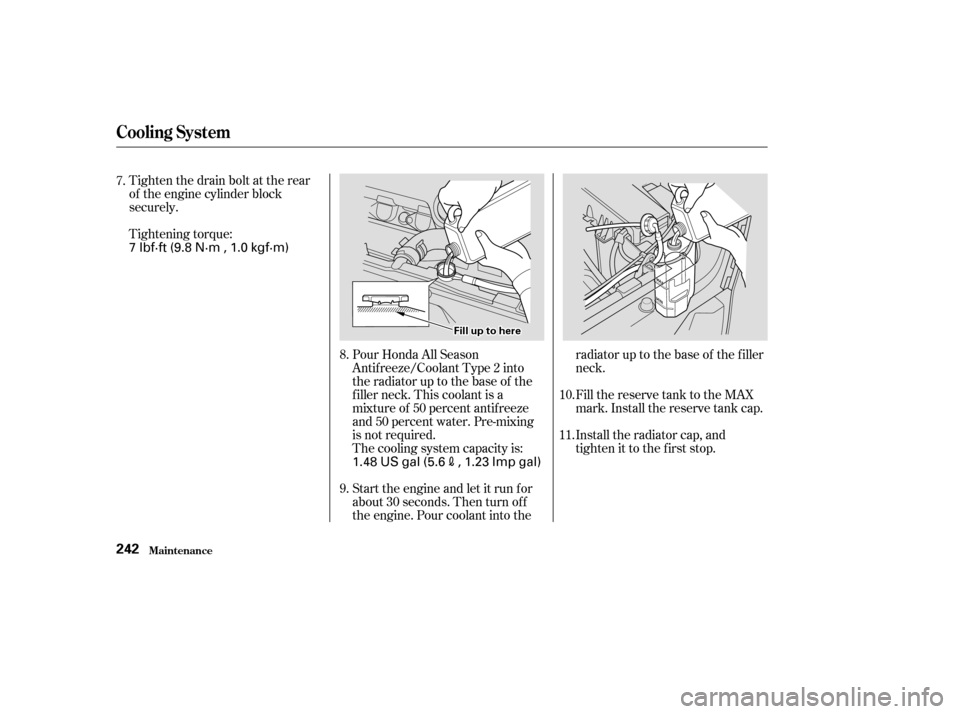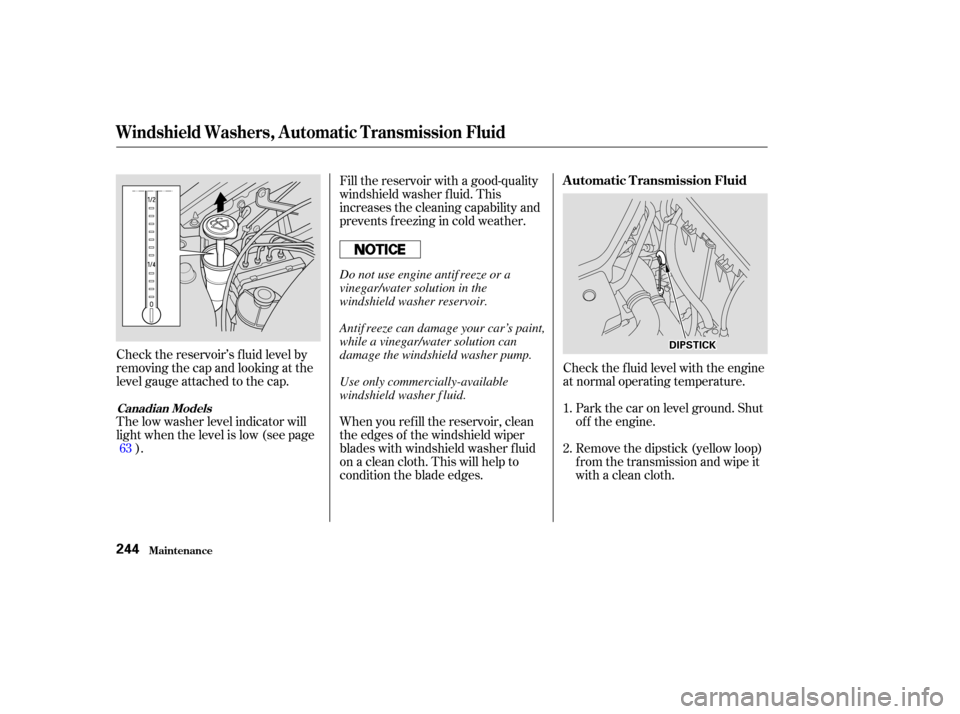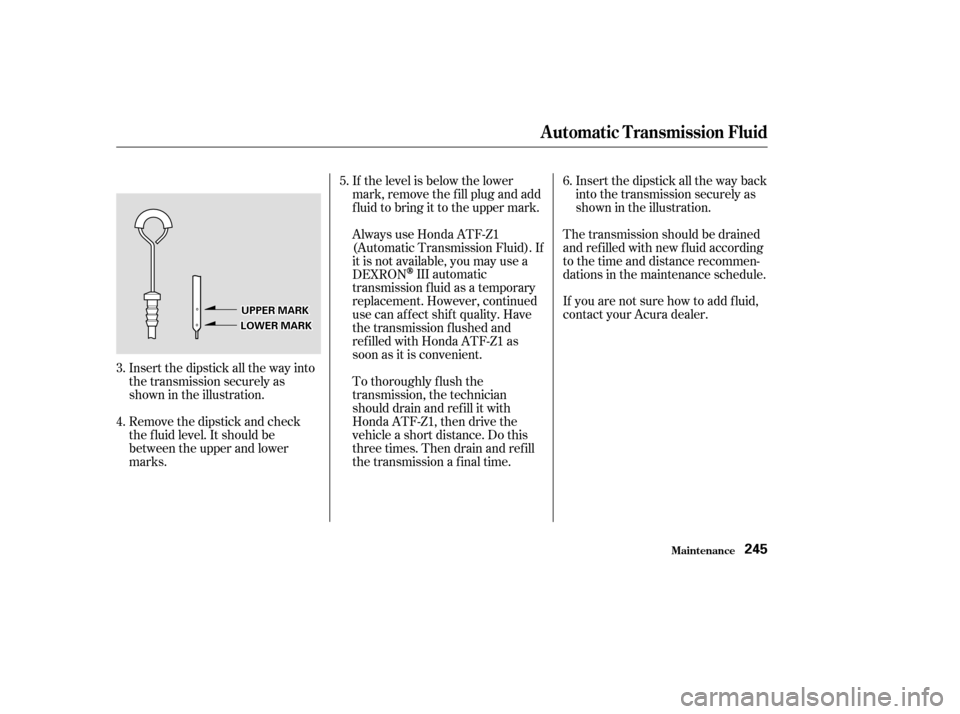Acura TL 2003 3.2 Owner's Manual
Manufacturer: ACURA, Model Year: 2003, Model line: TL, Model: Acura TL 2003Pages: 347, PDF Size: 4.14 MB
Page 241 of 347

If the coolant level in the reserve
tank is at or below the MIN line, add
coolant to bring it up to the MAX line.
Inspect the cooling system f or leaks.
The coolant you add should always
be a mixture of 50 percent antif reeze
and 50 percent water. Never add
straight antif reeze or plain water.If the reserve tank is completely
empty, you should also check the
coolant level in the radiator.
Always use Honda All Season
Antif reeze/Coolant Type 2. This
coolant is pre-mixed with 50 percent
antif reeze and 50 percent water. It
does not require any additional
mixing. If it is not available, you may
use another major-brand non-silicate
coolant as a temporary replacement.
Make sure it is a high-quality coolant
recommended f or aluminum engines.
However, continued use of any non-
Honda coolant can result in
corrosion, causing the cooling
system to malf unction or f ail. Have
the cooling system f lushed and
ref illed with Honda antif reeze/
coolant as soon as possible.
A dding Engine Coolant
Cooling Syst em
Maint enance238
R RE
ES
SE ER
RV V E
E T
TA
A N
NK K
Removing the radiator cap
while the engine is hot can
cause the coolant to spray out,
seriously scalding you.
Always let the engine and
radiator cool down before
removing the radiator cap.
Page 242 of 347

CONT INUED
Turn the radiator cap counter-
clockwise, without pressing down
on it, until it stops. This relieves
any pressure remaining in the
cooling system. Make sure the engine and radiator
are cool.Remove the radiator cap by
pushing down and turning
counterclockwise.
The coolant level should be up to
the base of the f iller neck. Add
coolant if it is low.
Put the radiator cap back on.
Tighten it f ully.
3.
1.
2. 4.
5.
Cooling Syst em
Maint enance239
R RA
A D
DI
IAA T
TO
OR R C
CAA P
P
Page 243 of 347

Pour coolant into the reserve tank.
Fill it to half way between the MAX
and MIN marks. Put the cap back
on the reserve tank.Do not add any rust inhibitors or
other additives to your car’s cooling
system. They may not be compatible
with the coolant or engine compo-
nents.
Thecoolingsystemshouldbe
completely drained and ref illed with
new coolant according to the time
and distance recommendations in
the maintenance schedule. Only use
Honda All Season Antif reeze/
Coolant Type 2. Use of any non-
Honda coolant or plain water can
result in corrosion and deposits in
the cooling system.
Draining the coolant requires access
to the underside of the car. Unless
you have the tools and knowledge,
you should have this maintenance
done by a skilled mechanic.
6. Replacing Engine Coolant
Cooling Syst em
Maint enance240
R RE
ES
SE ER
RV V E
E T
TA
A N
NK K
Page 244 of 347

CONT INUED
Remove the reserve tank f rom its
holder by pulling it straight up.
Drain the coolant, then put the
tank back in its holder.
When the coolant stops draining,
tightenthedrainplugatthe
bottom of the radiator.
Turn the ignition ON (II). Turn
the heater temperature control
dial to maximum heat (climate
control to 90°F/32°C). Turn of f
the ignition. Open the hood. Make
sure the engine and radiator are
cool to the touch.
Remove the radiator cap. Loosen the drain plug on the
bottom of the radiator. The
coolant will drain through the
splash guard.
Install a rubber hose on the drain
bolt at the rear of the engine
cylinder block. Loosen the drain
bolt.
3.
1.
2. 4.5.
6.
Cooling Syst em
Maint enance241
D D
R
RAA I
INN P
PL
LUUG G R
REES
SE ER
RV V E
E T
TA
A N
NK K C
CAA P
P
H
H O
OL LDD E
ER
R R
RE
ES
SE ER
RV V E
E T
TA
A N
NK K
D
D R
RAA I
INN B
BOOL LTT
Page 245 of 347

Tighten the drain bolt at the rear
of the engine cylinder block
securely.
Tightening torque:Pour Honda All Season
Antif reeze/Coolant Type 2 into
the radiator up to the base of the
f iller neck. This coolant is a
mixture of 50 percent antif reeze
and 50 percent water. Pre-mixing
is not required.
The cooling system capacity is:
Start the engine and let it run f or
about 30 seconds. Then turn of f
the engine. Pour coolant into theradiator up to the base of the f iller
neck.
Fill the reserve tank to the MAX
mark. Install the reserve tank cap.
Install the radiator cap, and
tighten it to the first stop.
7.
8.
9.10.
11.
Cooling Syst em
Maint enance242
F Fi illll u
u p
p t
too h
he
erree
7 lbf·ft (9.8 N·m , 1.0 kgf·m)
1.48 US gal (5.6
, 1.23 Imp gal)
Page 246 of 347

If necessary, f ill the reserve tank
to the MAX mark. Install the
reserve tank cap.
Install the radiator cap, and
tighten it fully. Start the engine and hold it at
1,500 rpm until the cooling f an
comes on. Turn of f the engine.
Check the coolant level in the
radiator and add coolant if needed. Remove the radiator cap. Pour
coolant into the radiator up to the
base of the f iller neck and into the
reserve tank up to the MAX mark. Start the engine and let it run until
the radiator cooling f an comes on
at least twice. Then stop the
engine. Check the level in the windshield
washer reservoir at least monthly
during normal usage. In bad weather,
when you use the washers of ten,
check the level every time you stop
for fuel.
The windshield washer reservoir is
located behind the passenger’s side
headlight.
12.
13.
14.
15. 16.
CONT INUED
Maint enance
Cooling System, Windshield Washers
Windshield Washers
243
Page 247 of 347

Check the f luid level with the engine
at normal operating temperature.Park the car on level ground. Shut
of f the engine.
Remove the dipstick (yellow loop)
f rom the transmission and wipe it
with a clean cloth.
Fill the reservoir with a good-quality
windshield washer f luid. This
increases the cleaning capability and
prevents f reezing in cold weather.
When you ref ill the reservoir, clean
the edges of the windshield wiper
blades with windshield washer f luid
on a clean cloth. This will help to
condition the blade edges.
Check the reservoir’s f luid level by
removing the cap and looking at the
level gauge attached to the cap.
The low washer level indicator will
light when the level is low (see page
). 1.
2.
63
Maint enance
Windshield Washers, A ut omat ic T ransmission Fluid
Automatic Transmission Fluid
Canadian Models
244
D D I
IPP S
ST TI
ICCK K
Do not use engine antif reeze or a
vinegar/water solution in the
windshield washer reservoir.
Antif reeze can damage your car’s paint,
while a vinegar/water solution can
damage the windshield washer pump.
Use only commercially-available
windshield washer f luid.
Page 248 of 347

Insert the dipstick all the way into
the transmission securely as
shown in the illustration.
Remove the dipstick and check
the f luid level. It should be
between the upper and lower
marks.If the level is below the lower
mark, remove the f ill plug and add
f luid to bring it to the upper mark.
Insert the dipstick all the way back
into the transmission securely as
shown in the illustration.
The transmission should be drained
and ref illed with new f luid according
to the time and distance recommen-
dations in the maintenance schedule.
If you are not sure how to add f luid,
contact your Acura dealer.
Always use Honda ATF-Z1
(Automatic Transmission Fluid). If
it is not available, you may use a
DEXRON
III automatic
transmission f luid as a temporary
replacement. However, continued
use can affect shift quality. Have
the transmission f lushed and
ref illed with Honda ATF-Z1 as
soon as it is convenient.
To thoroughly f lush the
transmission, the technician
should drain and ref ill it with
Honda ATF-Z1, then drive the
vehicle a short distance. Do this
three times. Then drain and ref ill
the transmission a final time.
3. 5.
6.
4.
Maint enance
Automatic Transmission Fluid
245
U UP PP
PE
ER
R M
M A
AR
RKK
L
LO OW WE ER
R M
M A
AR
RKK
Page 249 of 347

The f luid level should be between
theMINandMAXmarksontheside
of the reservoir. If the level is at or
below the MIN mark, your brake
system needs attention. Have the
brake system inspected f or leaks or
worn brake pads.
Always use Honda Heavy Duty
Brake Fluid DOT 3. If it is not
available, you should use only DOT 3
or DOT 4 f luid, f rom a sealed
container, as a temporary
replacement. However, the use of
any non-Honda brake fluid can cause
corrosion and decrease the lif e of the
system. Have the brake system
f lushed and ref illed with Honda
Heavy Duty Brake Fluid DOT 3 as
soon as possible.
Check the f luid level in the brake
f luid reservoir monthly.
The brake f luid should be replaced
according to the time recommenda-
tion in the maintenance schedule.
Brake f luid marked DOT 5 is not
compatible with your car’s braking
system and can cause extensive
damage.Brake System
Maint enance
Brake Fluid
246
M M
A
AX
X
M
M I
INN
Page 250 of 347

Check the level when the engine is
cold. Look at the side of the
reservoir. The f luid should be
between the UPPER LEVEL and
LOWER LEVEL. If it is below the
LOWER LEVEL, add power steering
f luid to the UPPER LEVEL.Always use Honda Power Steering
Fluid. If it is not available, you may
use another power steering f luid as
an emergency replacement.
However, continued use can cause
increased wear and poor steering in
cold weather. Have the power
steering system f lushed and ref illed
with Honda PSF as soon as possible.
A low power steering f luid level can
indicate a leak in the system. Check
the f luid level f requently and have
the system inspected as soon as
possible.
Clean the hood latch assembly with a
mild cleaner, then lubricate it with a
multipurpose grease. Lubricate all
the moving parts (as shown),
including the pivot. Follow the time
and distance recommendations in
the Maintenance Schedule. If you
are not sure how to clean and grease
the latch, contact your Acura dealer.
Maint enance
Power Steering Hood L atch
Power Steering, Hood L atch
247
M MA
AX
X
M
M I
INN L
LA
A T
TC
CH H
A
A S
SSSEEM
M B
BLLYY
T urning the steering wheel to f ull lef t
or right lock and holding it there can
damage the power steering pump.